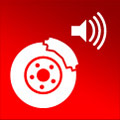YOU ARE IN CONTROL WITH OUR TECHNICAL TIPS
Light vehicles
There are many different types of brake noise. Here are explanations for each, with our recommended remedies.
Brake noise typically originates from vibration on a part within the wheel end section of the vehicle – between the tyre and the connection to the chassis. Noise is often blamed on the brake pad itself, but can come from any part, from the wheel bearing to the ball joint. Within the brake system, it's normal to have some vibration, but it is not usually intense enough to be audible.
TYPES OF NOISE EXPERIENCED BY DRIVERS

LOW FREQUENCY VIBRATIONS – JUDDER

DESCRIPTION
A deep noise with frequency below 300 Hz.
CAUSES
-
Poor tolerance
(poor fitment on the hub or excessive disc thickness variation). - Disc damage
SOLUTION
Replace the disc and clean and lubricate all surfaces of the brake assembly according to the vehicle manufacturer's instructions.
MEDIUM FREQUENCY VIBRATIONS – SQUEAL


DESCRIPTION
Noise with frequency in the range 300 - 5.000 Hz.
CAUSES
- Sticky movement on the caliper piston,
- non-planarity of the working surface of the disc,
- pad fitting errors,
- incorrect allocation of anti-noise fixings (eg. shims),
- disc thickness too low.
SOLUTION
- Clean and lubricate components of the caliper,
- ensure disc planarity (once fitted on to the hub) will stay within a tolerance of 0.1 mm.
- Clean the hub surface, machine disc surface,
- replace disc and make sure brake pads,
- shims and accessories are fitted properly.
- Consider damping noise intensity with shims or brake pads with noise-reduction features.
HIGH FREQUENCY VIBRATIONS – SQUEAK
DESCRIPTION
Noise with frequency higher than 5 kHz
CAUSES
The most common reason for a squeak is a molecular vibration within the friction material during application to the brake disc.
SOLUTION
Replace the brake pad set. Also check that the accessories (e.g. the caliper clips) are correct and properly fitted
VERY HIGH FREQUENCY VIBRATIONS – ULTRASOUND
DESCRIPTION
Noise with frequency higher than 12 KHz, greater than the upper limit of human hearing.
FRICTION SURFACES GIVE VITAL CLUES
The appearance of the friction surfaces can give a good indication of the causes of noise problems. Jack up the vehicle, remove the pads and examine the friction surfaces to analyse potential problems. Below are five symptoms that relate to noise.
SYMPTOMS AND REMEDIES
TAPERED PADS

APPEARANCE
Uneven wear, tapered pads
CAUSE
Distorted caliper, caliper slides sticking, excessive caliper clearance
EFFECT
Premature pad wear, uneven braking pressure, noise
REMEDY
Replace pad set, maintain & service caliper
UNEVEN WEAR

APPEARANCE
Uneven wear on pad surface
CAUSE
Irregularly worn brake disc (a wear lip will be visible on the disc)
EFFECT
Squeal & judder, premature pad wear
REMEDY
Replace brake discs and pads
UNEVEN WEAR WITHIN AXLE

APPEARANCE
One or more brake pad within the axle set will be excessively worn
CAUSE
Caliper guide pins or piston sticking
EFFECT
The vehicle pulls to one side while braking, uneven & rapid pad wear, squeal & judder
REMEDY
Maintain all caliper slides & pistons, replace pads. Check discs
DAMAGED BACK PLATE

APPEARANCE
Damaged back plate
CAUSE
Incorrect assembly, excessive force used during fitting
EFFECT
Braking inefficiency, irregular wear, noise & judder
REMEDY
Replace full brake pad set
PISTON DAMAGE

APPEARANCE
Anti-noise features (rubber-coat / shim) damaged by piston
CAUSE
Piston not retracting fully, heavy brake use
EFFECT
Overheating, noise
REMEDY
Replace brake pad set, maintain caliper
AVOIDING NOISE PROBLEMS
The easiest way to avoid problems is to ensure that the brake pads and caliper are correctly assembled.
Tips for correct assembly:

-
Strip and clean all the caliper
slides and pins.

-
Emery paper can only be used on the
caliper and pad abutments in the
case of heavy rust or pollutants.
Note: if the caliper is not sliding easily, this can result in tapered pads or uneven wear within the axle, which creates squeal and judder.

-
The pins must have the correct
lubrication to ensure free movement
so that the pin does not seize into
the caliper body. Also, check the
condition of the slide pin rubber
boots to stop water ingress.
Note: if the pins are not lubricated they may seize, causing wear taper and noise issues.

- Check for free piston movement, and retract the piston fully – this is essential to avoid damage to the shim or the rubber coat.

-
Check that the brake pads fit freely
and easily into the caliper
brackets.

-
Clear burrs off the brake pad edges
if required.
Note: if the pad is not moving freely inside the brackets, there will be ongoing contact with the discs, causing squealing as well as tapered pads or uneven wear within the axle.

-
In certain cases (e.g. an old rusted
caliper), it is a good idea to
lightly lubricate the contact points
between metal back plate and slides
with copper grease, according to the
vehicle manufacturer's instructions.
Note: take care that NO grease touches the friction material.

-
Insert wear indicators, when
appropriate, in or on the brake
pads.
-
Screw in the caliper fixing-bolts.
-
Replace the thread-lock bolts with
new ones.

- Follow the correct tightening torque and sequence recommendations.
- With the brake caliper reassembled, pump the brake pedal until the stroke is around one third of the full stroke potential.
-
Check that the brake operates
correctly, including pad retraction.
-
Refit road wheel. If there is free
rotation, the vehicle is ready to go
back on the road.
Note: do a road test before returning the vehicle to make sure that the brake system is in full working order. When you return the car to the driver, advise them on the correct bedding-in procedure to ensure proper brake efficiency. We have created a handy.
Driver Tips leaflet you can use for this purpose – ask your local representative.
© Copyright 2015 OEFILIS Brake System.

